The Intel Optane Memory (SSD) Preview: 32GB of Kaby Lake Caching
by Billy Tallis on April 24, 2017 12:00 PM EST- Posted in
- SSDs
- Storage
- Intel
- PCIe SSD
- SSD Caching
- M.2
- NVMe
- 3D XPoint
- Optane
- Optane Memory
Random Read
Random read speed is the most difficult performance metric for flash-based SSDs to improve on. There is very limited opportunity for a drive to do useful prefetching or caching, and parallelism from multiple dies and channels can only help at higher queue depths. The NVMe protocol reduces overhead slightly, but even a high-end enterprise PCIe SSDs can struggle to offer random read throughput that would saturate a SATA link.
Real-world random reads are often blocking operations for an application, such as when traversing the filesystem to look up which logical blocks store the contents of a file. Opening even an non-fragmented file can require the OS to perform a chain of several random reads, and since each is dependent on the result of the last, they cannot be queued.
These tests were conducted on the Optane Memory as a standalone SSD, not in any caching configuration.
Queue Depth 1
Our first test of random read performance looks at the dependence on transfer size. Most SSDs focus on 4kB random access as that is the most common page size for virtual memory systems and it is a common filesystem block size. For our test, each transfer size was tested for four minutes and the statistics exclude the first minute. The drives were preconditioned to steady state by filling them with 4kB random writes twice over.
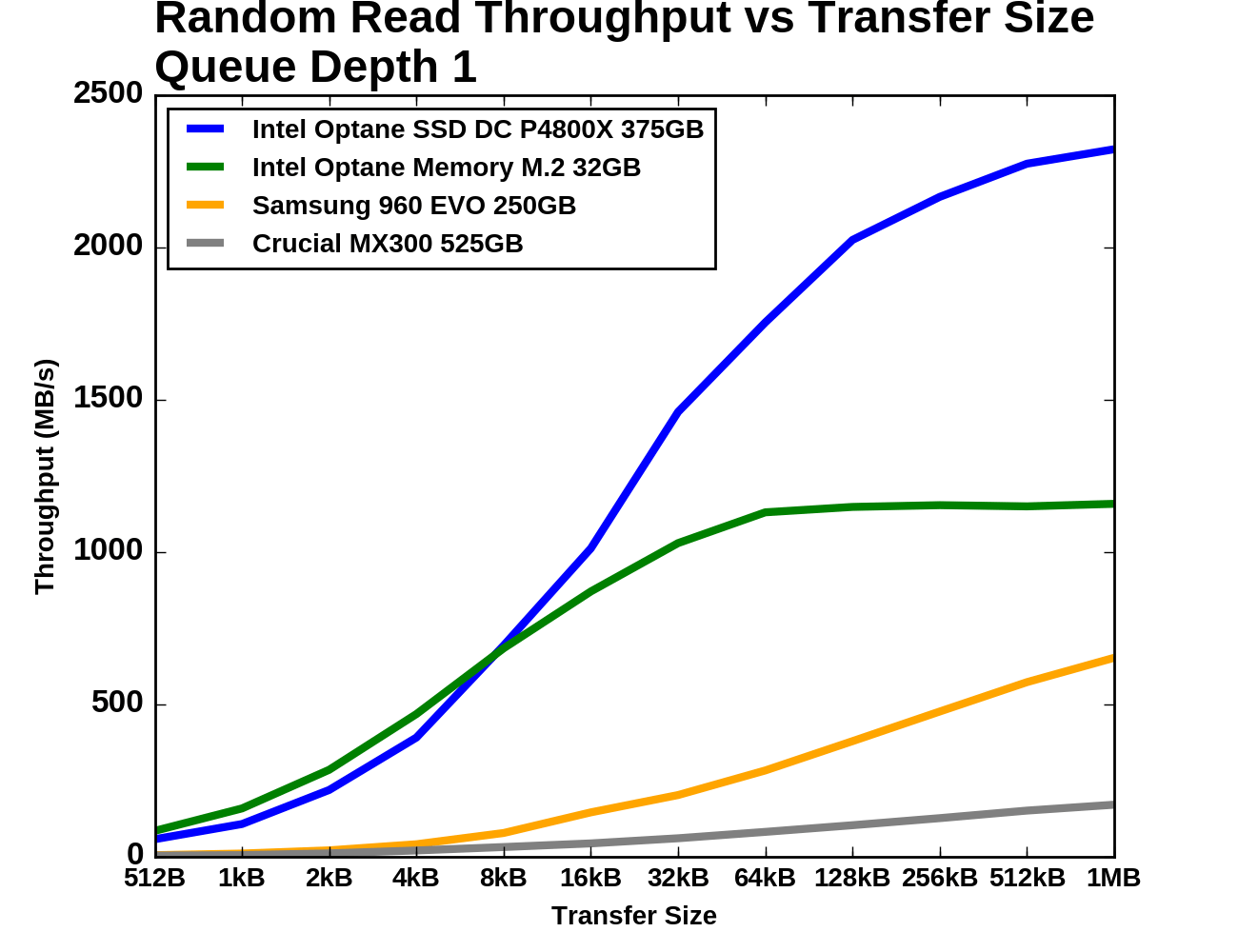 |
|||||||||
| Vertical Axis scale: | Linear | Logarithmic | |||||||
The Optane Memory module manages to provide slightly higher performance than even the P4800X for small random reads, though it levels out at about half the performance for larger transfers. The Samsung 960 EVO starts out about ten times slower than the Optane Memory but narrows the gap in the second half of the test. The Crucial MX300 is behind the Optane memory by more than a factor of ten through most of the test.
Queue Depth >1
Next, we consider 4kB random read performance at queue depths greater than one. A single-threaded process is not capable of saturating the Optane SSD DC P4800X with random reads so this test is conducted with up to four threads. The queue depths of each thread are adjusted so that the queue depth seen by the SSD varies from 1 to 16. The timing is the same as for the other tests: four minutes for each tested queue depth, with the first minute excluded from the statistics.
The SATA, flash NVMe and two Optane products are each clearly occupying different regimes of performance, though there is some overlap between the two Optane devices. Except at QD1, the Optane Memory offers lower throughput and higher latency than the P4800X. By QD16 the Samsung 960 EVO is able to exceed the throughput of the Optane Memory at QD1, but only with an order of magnitude more latency.
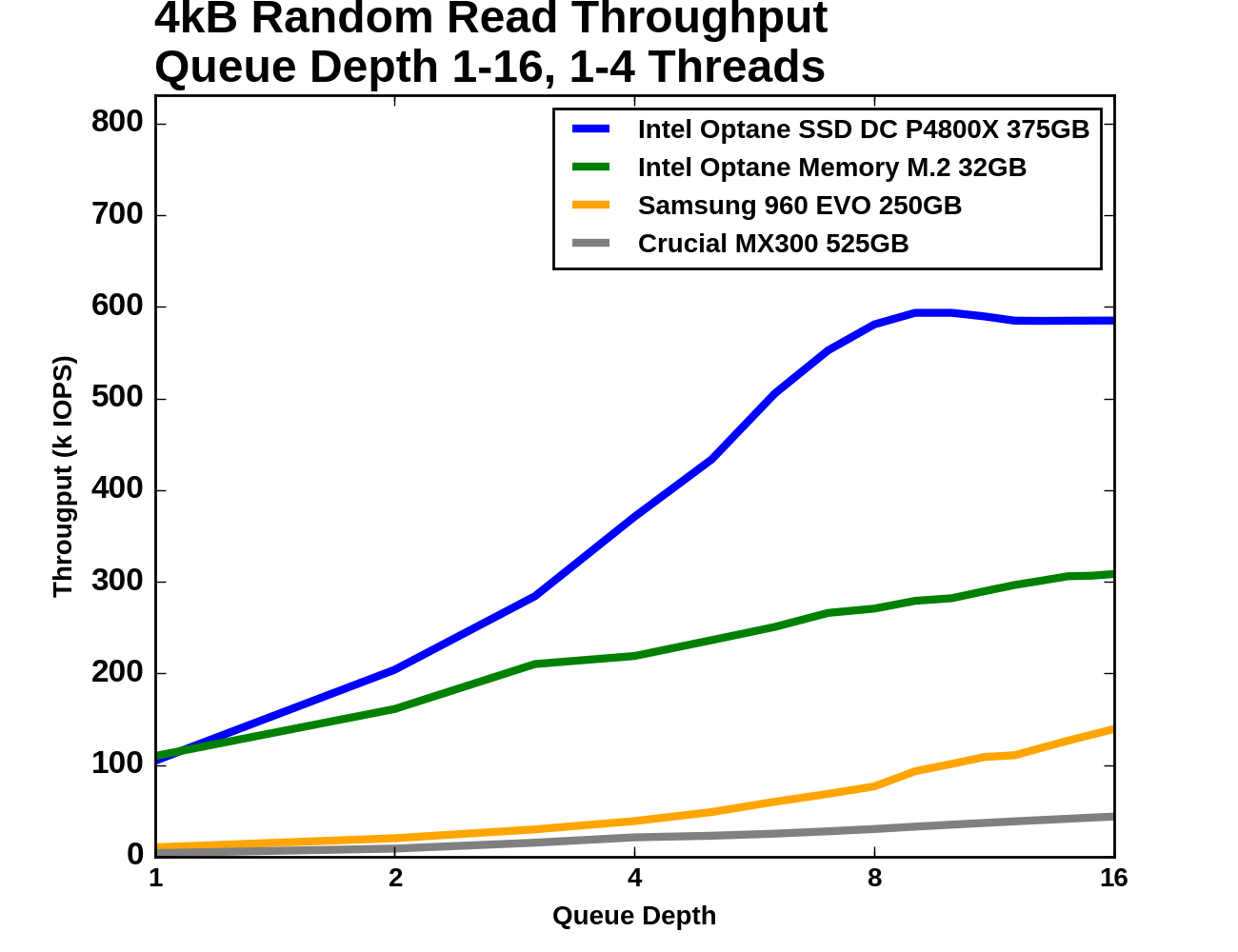 |
|||||||||
| Vertical Axis scale: | Linear | Logarithmic | |||||||
Comparing random read throughput of the Optane SSDs against the flash SSDs at low queue depths requires plotting on a log scale. The Optane Memory's lead over the Samsung 960 EVO is much larger than the 960 EVO's lead over the Crucial MX300. Even at QD16 the Optane Memory holds on to a 2x advantage over the 960 EVO and a 6x advantage over the MX300. Over the course of the test from QD1 to QD16, the Optane Memory's random read throughput roughly triples.
 |
|||||||||
| Mean | Median | 99th Percentile | 99.999th Percentile | ||||||
For mean and median random read latency, the two Optane drives are relatively close at low queue depths and far faster than either flash SSD. The 99th and 99.999th percentile latencies of the Samsung 960 EVO are only about twice as high as the Optane Memory while the Crucial MX300 falls further behind with outliers in excess of 20ms.
Random Write
Flash memory write operations are far slower than read operations. This is not always reflected in the performance specifications of SSDs because writes can be deferred and combined, allowing the SSD to signal completion before the data has actually moved from the drive's cache to the flash memory. Consumer workloads consist of far more reads than writes, but there are enough sources of random writes that they also matter to everyday interactive use. These tests were conducted on the Optane Memory as a standalone SSD, not in any caching configuration.
Queue Depth 1
As with random reads, we first examine QD1 random write performance of different transfer sizes. 4kB is usually the most important size, but some applications will make smaller writes when the drive has a 512B sector size. Larger transfer sizes make the workload somewhat less random, reducing the amount of bookkeeping the SSD controller needs to do and generally allowing for increased performance.
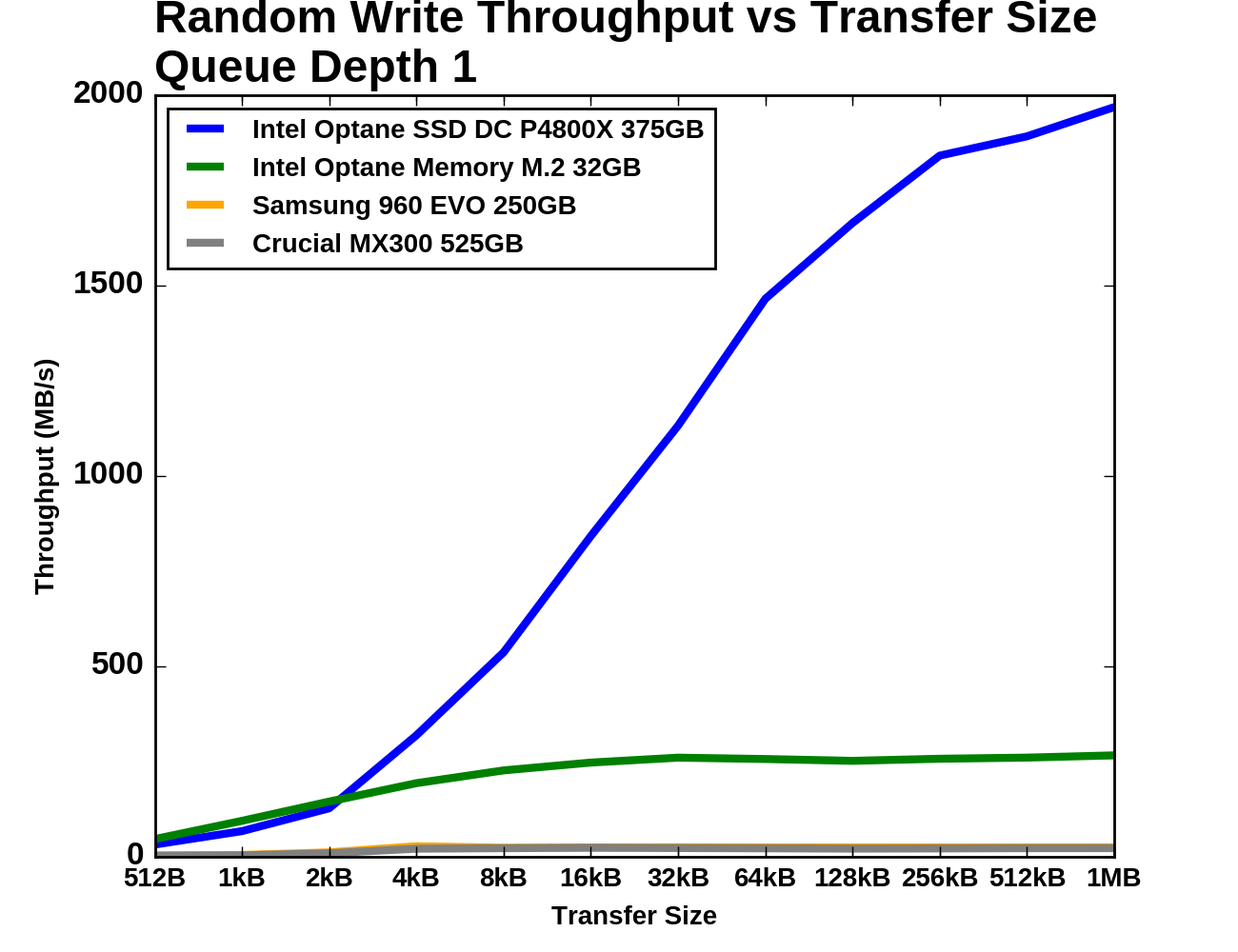 |
|||||||||
| Vertical Axis scale: | Linear | Logarithmic | |||||||
As with random reads, the Optane Memory holds a slight advantage over the P4800X for the smallest transfer sizes, but the enterprise Optane drive completely blows away the consumer Optane Memory for larger transfers. The consumer flash SSDs perform quite similarly in this steady-state test and are consistently about an order of magnitude slower than the Optane Memory.
Queue Depth >1
The test of 4kB random write throughput at different queue depths is structured identically to its counterpart random write test above. Queue depths from 1 to 16 are tested, with up to four threads used to generate this workload. Each tested queue depth is run for four minutes and the first minute is ignored when computing the statistics.
With the Optane SSD DC P4800X included on this graph, the two flash SSDs are have barely perceptible random write throughput, and the Optane Memory's throughput and latency both fall roughly in the middle of the gap between the P4800X and the flash SSDs. The random write latency of the Optane Memory is more than twice that of the P4800X at QD1 and is close to the latency of the Samsung 960 EVO, while the Crucial MX300 starts at about twice that latency.
 |
|||||||||
| Vertical Axis scale: | Linear | Logarithmic | |||||||
When testing across the range of queue depths and at steady state, the 525GB Crucial MX300 is always delivering higher throughput than the Samsung 960 EVO, but with substantial inconsistency at higher queue depths. The Optane Memory almost doubles in throughput from QD1 to QD2, and is completely flat thereafter while the P4800X continues to improve until QD8.
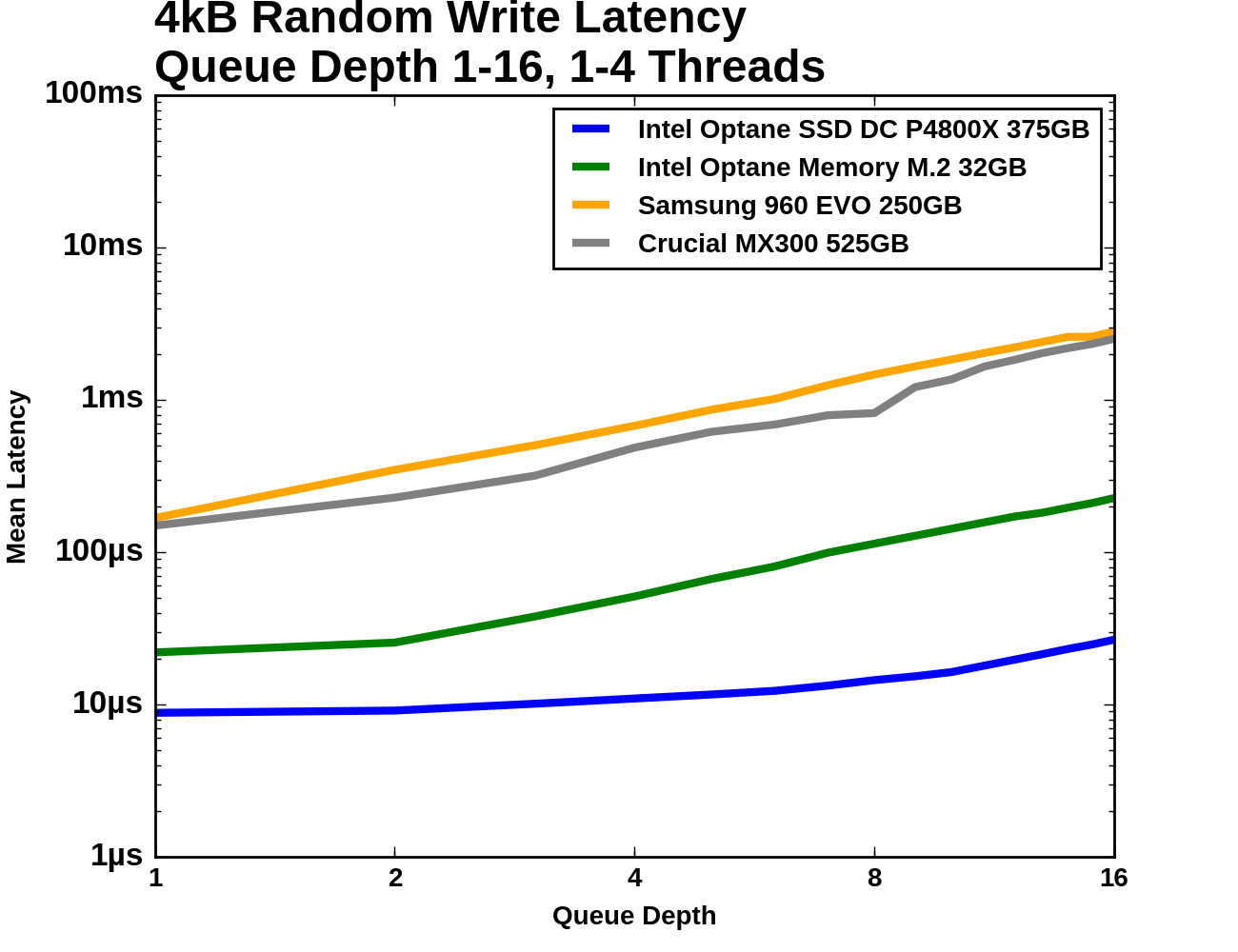 |
|||||||||
| Mean | Median | 99th Percentile | 99.999th Percentile | ||||||
The Optane Memory and Samsung 960 EVO start out with the same median latency at QD1 and QD2 of about 20µs. The Optane Memory's latency increases linearly with queue depth after that due to its throughput being saturated, but the 960 EVO's latency stays lower until near the end of the test. The Samsung 960 EVO has relatively poor 99th percentile latency to begin with and is joined by the Crucial MX300 once it has saturated its throughput, while the Optane Memory's latency degrades gradually in the face of overwhelming queue depths. The 99.999th percentile latency of the flash-based consumer SSDs is about 300-400 times that of the Optane Memory.


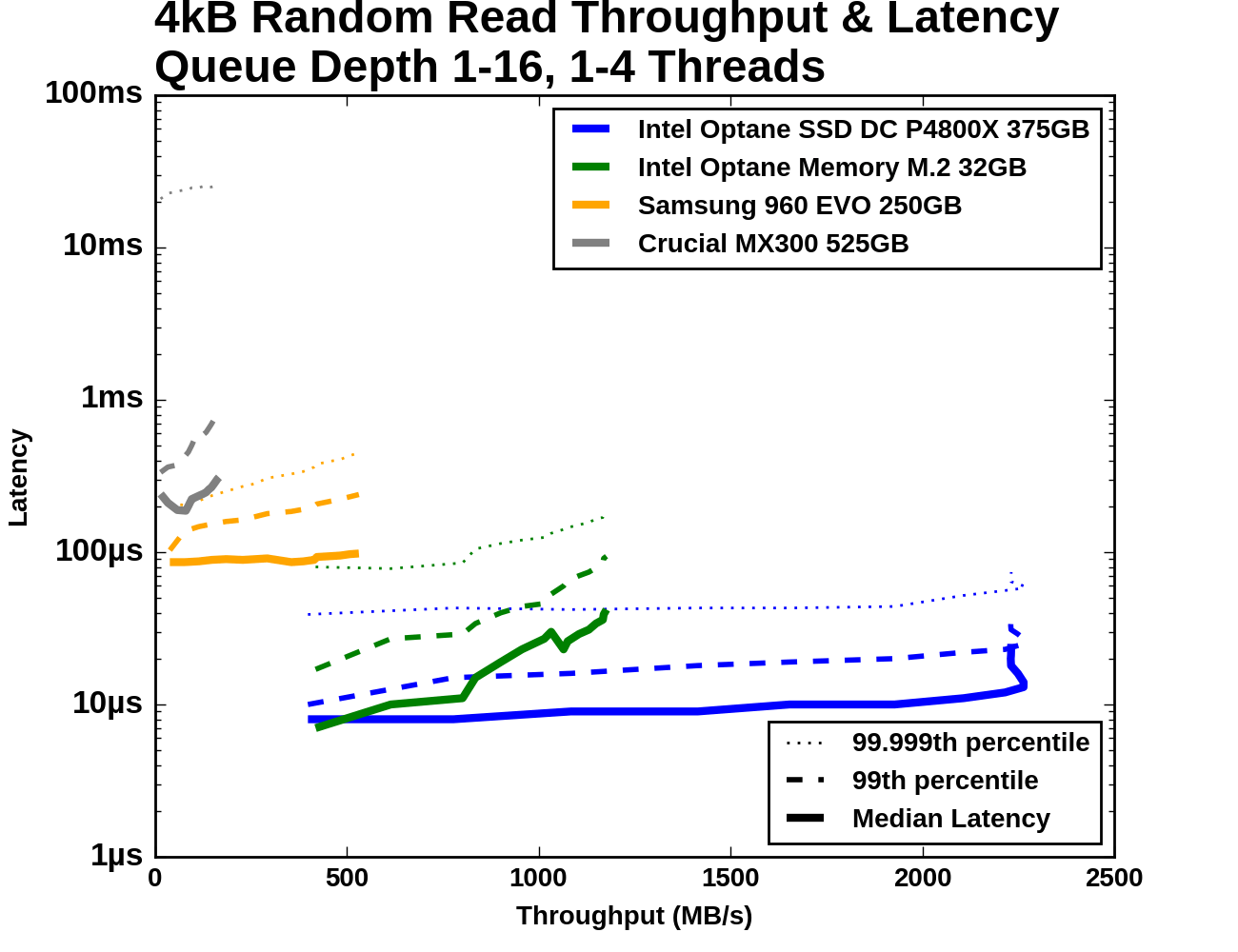
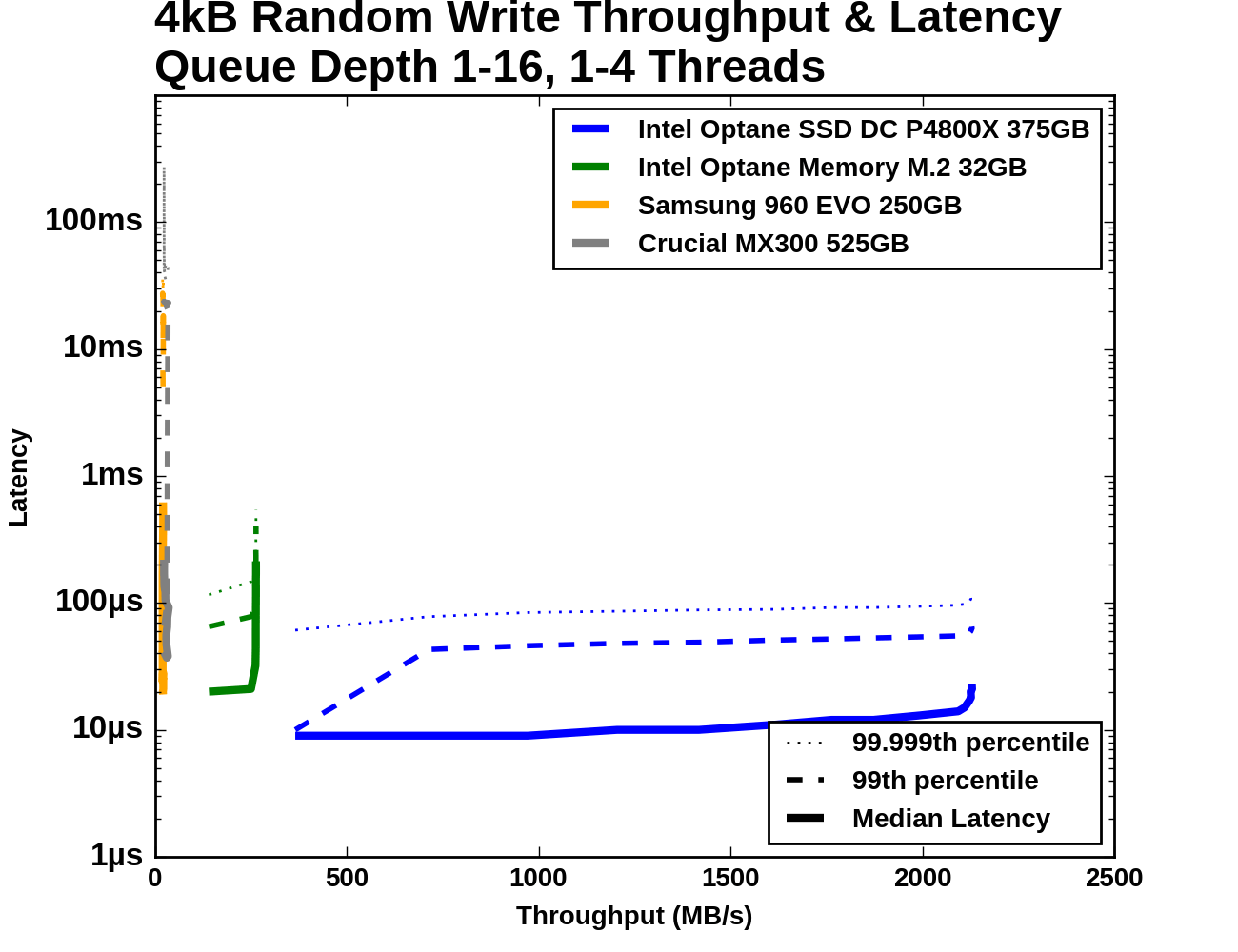








110 Comments
View All Comments
ddriver - Wednesday, April 26, 2017 - link
It is only natural to have negative sentiments about greedy, lousy corporations because of what they do. It is nothing personal though, I do it because I am a conscious human being. Not cattle. You can throw crapple and moogle into the mix. There is no single good reason to be fond of any corporation. The bigger they are the more damage they do to humanity and the planet as a whole.In other news, water is wet!
eddman - Wednesday, April 26, 2017 - link
You are not fooling anyone.eddman - Wednesday, April 26, 2017 - link
...and you are so blind by your hatred that you dismiss every single thing that these companies do. You are not rational in the slightest but do like to boast about how great you are.Reflex - Tuesday, April 25, 2017 - link
Nailed it eddman. Because it does not personally solve ddriver's problems, or because it comes from the wrong brand, its an epic disaster. The funny thing here is I agree this is not a revolution, at least not yet, but the incessant bashing and inability to acknowledge that it has its uses and those use cases are likely to only grow demonstrates the bias involved.Reflex - Tuesday, April 25, 2017 - link
To the insinuation that Optane may somehow be relabeled SLC NAND, I went and did a little research/consultation. All NAND requires writing to blocks, Optane can support bit level writes (expected in DIMM configurations), which is a major advantage over NAND and not technically possible with NAND. It was also pointed out that if Optane was simply disguised SLC, despite the technical impossibility, it would mean that Intel had engaged in financial fraud by materially misrepresenting its technology, capabilities and long-term expectations to investors.Thanks to Joel Hruska for looking into it for me.
More info here: https://arstechnica.com/gadgets/2017/04/intel-opta...
More from Joel here: https://www.extremetech.com/author/jhruska
Reflex - Monday, April 24, 2017 - link
OMG it's the fastest product on the market in its class but because I choose to interpret the early marketing as applying to the first gen product it totally sucks! I refuse to benefit from drastically better performance because Intel *dared* to speak to its potential performance and didn't deliver that in the first product!In fact, I am so enraged I'm ripping out all my existing SSD's and replacing them with Quantum Bigfoot drives in protest.
Drumsticks - Monday, April 24, 2017 - link
It's probably because Intel dared to do something innovative again, and we can't possibly give credit where it's due, can we? If it was Samsung, I bet it would just be Samsung being Samsung. Slap the blue name on top, and it's cool to criticize whatever you can, even in the face of hard numbers. Make sure you also include an edgy name like "Hypetane" to really drive your point home.Reflex - Monday, April 24, 2017 - link
To be fair if it were Samsung we'd get a lecture on the oppression of North Korea mixed in there somewhere along with a conspiracy theory about the south being a puppet state not permitted to succeed in the face of America.jabbadap - Monday, April 24, 2017 - link
Well I don't want to degrade intel's efforts on this. But it's intel/micron co-operation who have engineered this and I would even guess a bit further that science behind this is more micron tech than intels.Drumsticks - Monday, April 24, 2017 - link
That's fair, and Micron definitely deserves credit as well. I'm sure they'll get their own when QuantX comes out, hopefully sometime this year. I suspect that the R&D was split very evenly, though; Intel has always been good at doing things "well" in the fab; Micron had excelled at doing them "cheaply" which is one reason the venture was reasonably successful. Plus, I feel it would be hard to collaborate on R&D together for 10 years and successfully say "we did this together" to the public, if one side (Micron or Intel) did most of the work. I guess we'll never know, though.